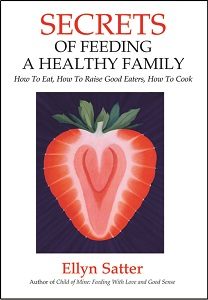

Family Meals Focus
The Ellyn Satter Institute Newsletter
Should you follow MyPlate?
MyPlate replaces MyPyramid, an earlier USDA Dietary Guidelines-based nutrition education plan. While it is less complicated to follow, MyPlate still tells you what and how much to eat. Instead of following either, consider becoming eating competent. You can enjoy your eating and feel good about it at the same time as you work toward the Dietary Guidelines outcomes of achieving and maintaining good health and reducing the risk of chronic disease.
MyPlate is less complicated than the Food Guide Pyramid
The Food Guide Pyramid was abandoned on the grounds that it was too complicated to follow and MyPlate developed with the goal of being simpler. MyPlate is not the same as the Dietary Guidelines, nor was the Food Guide Pyramid. Both are nutrition education strategies created by USDA as plans assumed to accomplish the goals of the Dietary Guidelines. There are other strategies for doing nutrition education, but MyPlate has visibility because USDA advertises. Also, some USDA Food and Nutrition Services (FNS) sponsored programs such as WIC, SNAP-Ed, Child and Adult Care Food Plan (CACFP), and EFNEP, are obligated to teach MyPlate. Others are not. If you receive funding from FNS, consider whether you must follow MyPlate or whether you may use a kinder, gentler nutrition education strategy.
- The graphic is less complicated than the Food Guide Pyramid.
- It recommends all the basic food groups: protein, grainss, fruits and vegetables, and dairy.
- It tacitly encourages meals. Doesn’t it? You don’t eat off a plate when you graze.
MyPlate is prescriptive
Consider whether you must follow MyPlate or whether you may use a kinder, gentler nutrition education strategy.
- It is still prescriptive. Consumers are tired of being told what and how much to eat.1
- It still emphasizes restriction and avoidance, so the overall feeling is negative. As such, it does nothing to heal consumers’ negative and conflicted eating attitudes and behaviors.1
- It still tries to get us to eat more than we need of fruits, vegetables and grains by stressing inflated “recommendations,” not requirements or minimums.
- It is confining. How do you get a chicken Caesar salad on MyPlate? Chili? Curry? Caldo de pollo con verduras (chicken and vegetable soup).
- It fails to emphasize family meals. This is despite considerable evidence of meals’ positive benefit2,3 and the pivotal importance of context management in the Satter Eating Competence Model (ecSatter).
- It fails to distinguish between what to put on the table and what to eat. Paying attention when you eat, you discover that appetite is happily fickle – what doesn’t taste good one day, does another.
- It ignores internal regulators. Is filling up the plate and eating it all, whether or not you are full, okay when it is mostly fruits and vegetables? No. It is still overeating. Chances are, you will still be hungry, as those low caloric density foods aren’t too filling and MyPlate stipulates low fat.
- Food enjoyment is still linked with “don’t eat so much.” Rather than trusting that appetite can be satisfied, it is as paying attention to what tastes good will lead to giddy self-indulgence, which in turn will carry us away.
- Salt, sugar, and fat, condiments that contribute to food enjoyment, are still vilified.
- It has been subjected to little or no consumer testing. To avoid doing harm, wide-ranging health and nutrition policy must be subjected to wide-ranging testing.
- Last, but not least, MyPlate isn’t suitable for children. It is too low in calories and fat. Moreover, loading up a plate for a child puts pressure on him or her to eat, and the child eats less well under those circumstances.
Achieve the Dietary Guidelines by building eating competence
Nobody asked me, but what would I do if I were designing nutrition education to achieve the goals of the Dietary Guidelines? I would help people to become eating competent. Research shows4–6 that people who score high on ecSI 2.0, the test for assessing eating competence, do better with respect to achieving the two basic Dietary Guidelines principles: 1) Maintain calorie balance over time to achieve and sustain a healthy weight. 2) Focus on consuming nutrient-dense foods and beverages.4–6 In short, my nutrition education strategy would be to stress helping people become eating competent.
- Address eating attitudes by stating unequivocally that eating is one of life’s great pleasures,7 and that family meals are an essential part of eating well.8
- Be firm about discipline:
- Maintain structure: have meals and sit-down snacks.
- Pay attention when you eat.9
- Give strong permission:
Structure is essential
People who structure their meals and snacks gradually work their way up the Satter Food Hierarchy and eat a greater variety of nutritious foods. People who have achieved food security gradually start to plan food, not just for immediate hunger but for the next day and several days. Applied with a light hand, these simple food selection and menu-planning guidelines can be helpful. But don’t let applying these principles make you rigid and negative. Absolutely avoid shoulds, oughts, and exaggerated recommendations for low-calorie foods.8
- Have meals made up of the basic food groups: Meat or other protein; a couple of starchy foods, fruit or vegetable or both; butter, salad dressing or gravy; and milk. Know the minimums to satisfy nutritional requirements.
- Be considerate without catering with meal-planning. Put together satisfying and rewarding meals that respect eaters’ various food preferences without limiting the menu to readily accepted foods.
- Use fat, salt, sugar, and other meal- and snack-time condiments to make food taste good. Such strategies, by their very nature, support moderation.
References
- Satter EM. Appendix C, What surveys say about our eating.Secrets of Feeding a Healthy Family: How to Eat, How to Raise Good Eaters, How to Cook. Madison, WI: Kelcy Press; 2008.
- Hammons AJ, Fiese BH. Is Frequency of Shared Family Meals Related to the Nutritional Health of Children and Adolescents? Pediatrics. June 1, 2011 2011;127(6):e1565-e1574.
- Satter EM. Appendix B, What the research says about meals. Secrets of Feeding a Healthy Family: How to Eat, How to Raise Good Eaters, How to Cook. Madison, WI: Kelcy Press; 2008:227-230.
- Lohse B, Satter E, Horacek T, Gebreselassie T, Oakland MJ. Measuring Eating Competence: psychometric properties and validity of the ecSatter Inventory. J Nutr Educ Behav. 2007;39 (suppl):S154-S166.
- Psota T, Lohse B, West S. Associations between eating competence and cardiovascular disease biomarkers. J Nutr Educ Behav. 2007;39 (suppl):S171-S178.
- Stotts JL, Lohse B. Eating competence level of low-income adults advocates for attention to intervention development. .J Nutr Educ Behav. 2007;39:S39.
- Satter EM. Chapter 2, Adjust Your Attitude. Secrets of Feeding a Healthy Family: How to Eat, How to Raise Good Eaters, How to Cook. Madison, WI: Kelcy Press; 2008:12-16.
- Satter EM. Chapter 5, Feed Yourself Faithfully. Secrets of Feeding a Healthy Family: How to Eat, How to Raise Good Eaters, How to Cook. Madison, WI: Kelcy Press; 2008:45-50.
- Satter EM. Chapter 3, Honor Your Appetite. Secrets of Feeding a Healthy Family: How to Eat, How to Raise Good Eaters, How to Cook. Madison, WI: Kelcy Press; 2008:17-25. 10. Satter EM. Chapter 4, Eat as Much as You Want. Secrets of Feeding a Healthy Family: How to Eat, How to Raise Good Eaters, How to Cook. Madison, WI: Kelcy Press; 2008:27-43.
Explore
Ellyn Satter’s Secrets of Feeding a Healthy Family says the secret of raising a healthy eater is to love good food, enjoy eating, and share that love and enjoyment with your child. When the joy goes out of eating, nutrition suffers.

Barbara Lohse, PhD, RD, LDN
- Define and describe the Satter Eating Competence model
- Identify the evidence base for the Satter Eating Competence model
- Frame public health goals with eating competence
Related issues of Family Meals Focus
- Eat what you like and be healthy!
- Dietary Guidelines 2010 and eating competence
- Eating competence and nutrition facts labels
- Practicing nutritional judo
- Should you control portion sizes?
- Should you put your child on skim milk?
- Stop being hysterical about “obesity!”
More about eating competence
- Eating competence: Context-management skills
- ecSI 2.0
- Evidence for ecSatter
- The joy of eating: Being a competent eater

